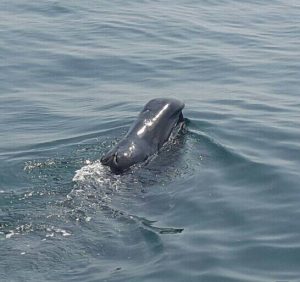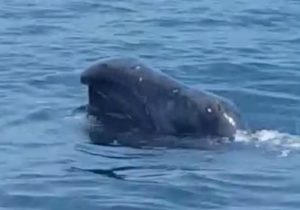Aquatic scientific names in the news …
Bowhead whale
29th May – A Bowhead whale was sighted off Carlingford Lough, Ireland. This is a rare sighting of an Arctic species, more than a thousand miles outside of its natural range and reportedly the first ever to be spotted in Irish waters; the whale was described as being around 20 foot long (just under 7 metres) so likely a juvenile. A sighting had been previously reported of a Bowhead of a similar size off Cornwall two weeks ago on May 15th, possibly the same individual. For more details of the current sighting see the Irish Whale and Dolphin Group (IWDG) website.
The Bowhead whale is the second largest species of whale after the Blue whale; generally measuring between 14 and 18 metres in length when fully grown (females usually a metre or so longer than males) and weigh from 75,000 to 100,000 kg. Calves have an average length at birth of 4.25 to 5.25 metres.
They have a large, robust, dark-colored body and a white chin/lower jaw. The common name of Bowhead derives from their bow-shaped mouth which features a strongly bowed lower jaw making a U-shape around the narrow upper jaw and is, incidentally, the largest mouth of any species.
Bowhead whales don’t appear to be social animals, typically traveling alone or in small pods of up to six. They are believed to be the longest lived mammal with an estimated lifespan of up to 200 years.
They are found only in Arctic and subarctic regions spending much of their lives in and near the pack ice, migrating to the high Arctic in summer, and retreating southward in winter with the advancing ice edge, and are rarely found below 45 degrees north latitude.
Balaena mysticetus Linnaeus, 1758 – Bowhead whale
Etymology.
Balaena – Latin, balaena, a whale.
mysticetus – Greek, μυστικητος, mysti–, mustac (μυσταξ), moustache, upper lip; -cetus (κητος), whale.
A possible alternative etymology derives from the assumption that there has been a transmission or translation error in older editions of Aristotle’s Historia Animalium; whereas modern editions read ο μυς το κητος, “the whale known as the mouse” or “the ‘mouse’, i.e. the whale so called’ (maybe an ironic reference to the animals’ great size), earlier editions mistakenly ran the words together as ο μυστικητος, “the Mysticetus”. Ref. OED

